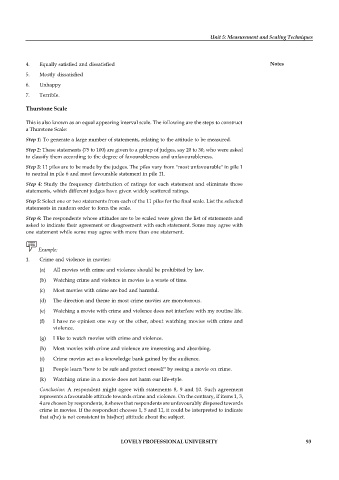Page 99 - DMGT404 RESEARCH_METHODOLOGY
P. 99
Unit 5: Measurement and Scaling Techniques
4. Equally satisfied and dissatisfied Notes
5. Mostly dissatisfied
6. Unhappy
7. Terrible.
Thurstone Scale
This is also known as an equal appearing interval scale. The following are the steps to construct
a Thurstone Scale:
Step 1: To generate a large number of statements, relating to the attitude to be measured.
Step 2: These statements (75 to 100) are given to a group of judges, say 20 to 30, who were asked
to classify them according to the degree of favourableness and unfavourableness.
Step 3: 11 piles are to be made by the judges. The piles vary from "most unfavourable" in pile 1
to neutral in pile 6 and most favourable statement in pile 11.
Step 4: Study the frequency distribution of ratings for each statement and eliminate those
statements, which different judges have given widely scattered ratings.
Step 5: Select one or two statements from each of the 11 piles for the final scale. List the selected
statements in random order to form the scale.
Step 6: The respondents whose attitudes are to be scaled were given the list of statements and
asked to indicate their agreement or disagreement with each statement. Some may agree with
one statement while some may agree with more than one statement.
Example:
1. Crime and violence in movies:
(a) All movies with crime and violence should be prohibited by law.
(b) Watching crime and violence in movies is a waste of time.
(c) Most movies with crime are bad and harmful.
(d) The direction and theme in most crime movies are monotonous.
(e) Watching a movie with crime and violence does not interfere with my routine life.
(f) I have no opinion one way or the other, about watching movies with crime and
violence.
(g) I like to watch movies with crime and violence.
(h) Most movies with crime and violence are interesting and absorbing.
(i) Crime movies act as a knowledge bank gained by the audience.
(j) People learn "how to be safe and protect oneself" by seeing a movie on crime.
(k) Watching crime in a movie does not harm our life-style.
Conclusion: A respondent might agree with statements 8, 9 and 10. Such agreement
represents a favourable attitude towards crime and violence. On the contrary, if items 1, 3,
4 are chosen by respondents, it shows that respondents are unfavourably disposed towards
crime in movies. If the respondent chooses 1, 5 and 11, it could be interpreted to indicate
that s(he) is not consistent in his(her) attitude about the subject.
LOVELY PROFESSIONAL UNIVERSITY 93

